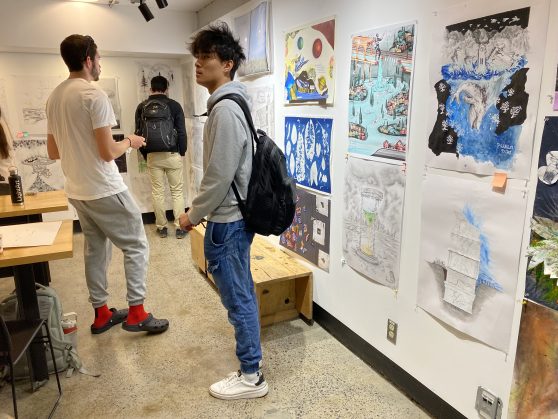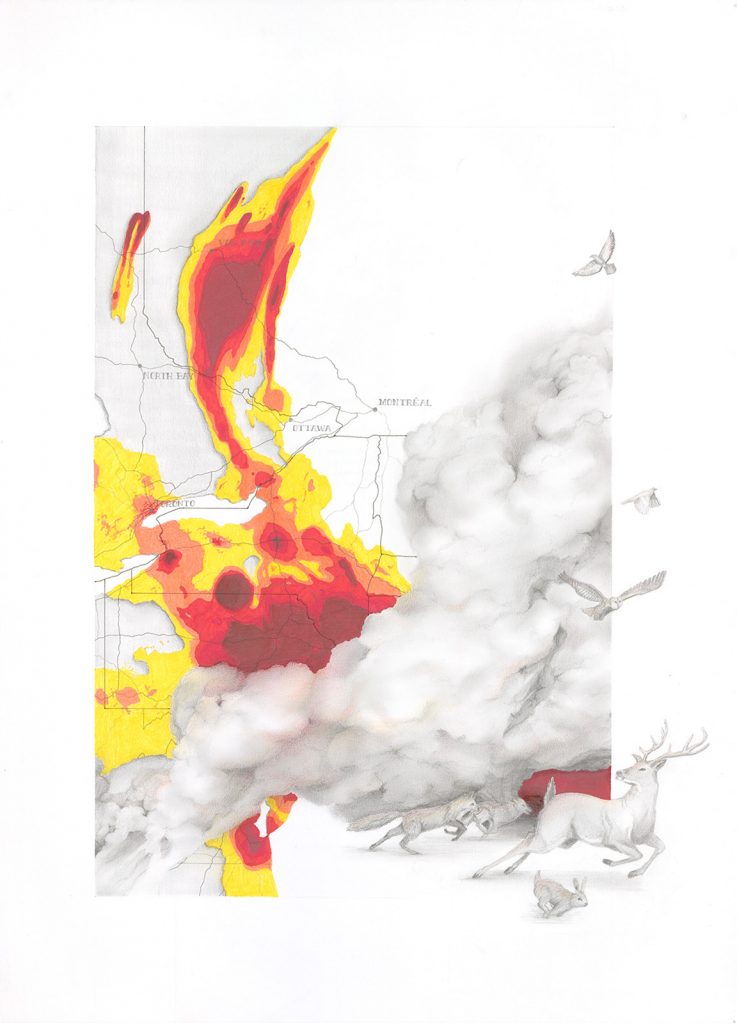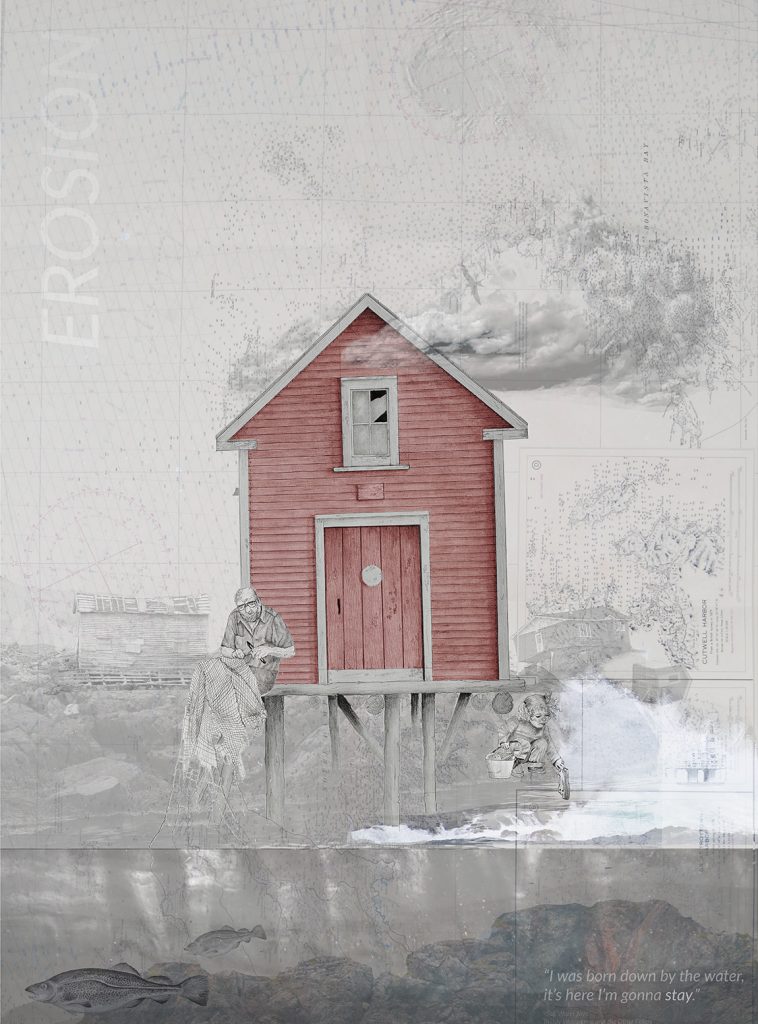Winners of the 2023 Murray & Murray Competition
September 15, 2023
The 20th edition of the Murray & Murray Competition attracted about 300 entries from students across the school on the theme of climate.
The jury selected three Murray & Murray Prize winners and three Honour Award recipients. They received a total of $6,000 in cash prizes.
“I had no idea of the extraordinary work that could magically appear in the course of a week,” said Director Anne Bordeleau. “I was very impressed by everything that you were able to put together.”
See the winners, images, and jury comments below.

The Murray & Murray Competition is a seven-day drawing competition that takes place in the first week of the Fall Term and celebrates the start of a new school year.
Tim Murray, the retired Ottawa architect who endowed the prize in 2003, was part of the jury and attended the awards presentation on September 13 in The Pit at the Architecture Building.
“I thought climate was a very apt choice for the subject for the contest this year,” he said. “Mother Earth is suffering badly, and mankind and womankind are highly dependent on people of your calibre to put things as right as you can.”
Dr. Bordeleau launched the competition on September 6, inviting students to engage with climate through their drawings, foregrounding ways in which design and the discipline of architecture intersect with these critical environmental changes.
“As we collectively take responsibility to address the climate emergency, the 2023 Murray & Murray competition likewise asks: how do we address, or apprehend, climate and the climate crisis? How do we face and work with this change?”
Out of about 300 entries, faculty and staff members chose 37 finalists for consideration by the following jury members.
Menna Agha, assistant professor, ASAU
Lisa Moffitt, associate professor, ASAU
Johan Voordouw, associate professor, ASAU
Tim Murray, retired Ottawa architect
Cassandra Moriartey, undergraduate administrator, ASAU
Rehab Salama, Ottawa intern architect
Karen Lindkvist, Ottawa architect and urban planner
The event concluded with a lecture by Associate Professor Lisa Moffitt on her new book, Architecture’s Model Environments.
A video featuring some highlights of the day can be viewed here.

First Prize ($2,000)
C.J. Dopheide, 4th year BAS (Design)

Title: A Moment of Unity
Description: There will be moments in our lives when we physically see the impacts we have imposed on our surrounding environment and moments when we take shelter from the atmosphere we have put into a state of flux. This summer, the emergence of forest fires surrounding Quebec resulted in a thick blanket of smoke, moving gradually into Ottawa and a large portion of Southern Ontario. While we each individually took shelter in our offices, cars, and homes, the wildlife of Canadian forests ran as they watched their habitat ignite in flames.
Jury Comments: This drawing conveys a clear message on pressing issues affecting Canadians and the world. The judges were unanimous in describing this drawing as striking. We liked the simplicity of it, the incorporation of the map of the Ottawa area, the forest fires that have been affecting us all summer, and the incredible hand-drawing skills.
Second Prize ($1,500)
Katie Stuart-Kiss, 1st year BAS (Conservation & Sustainability)

Title: Clearance: Community Gardens, Yellowknife
Description: This piece explores how extreme weather patterns are forcing people from built safe spaces. I visited Yellowknife in the summer of 2023, shortly before residents were forced to evacuate due to wildfires. I was drawn in by the idea of a community garden and how even the spaces that we build for a better future are put at risk by the climate crisis. In addition, my piece portrays how the people impacted are reduced to anonymity by the massive scale of natural disasters.
Jury Comments: The jury appreciated the drawing’s audacity to move away from architectural drawing techniques and go for right-out impressionistic technique. In this very pressing and bleak issue, it takes on a hopeful lens and centres on community, solidarity, land, and people coming together. It also suspends gender and creed in its representation. We felt something when we looked at this.
Third Prize ($1,000)
Alejandra Leon de Gante, MArch, thesis year

Title: Shifting Landscapes: The Great Sand Grab
Description: Sand is the second most-used resource after water. Modern civilization is built with sand. But it has come at an alarming price. Sand may be abundant, but not all types are fit for construction. Neither ocean nor desert sand can be used for concrete. Most optimal sand is drained from rivers. However, not all countries are equipped with sufficient supply. Demand has escalated illegal sand mining with powerful mafias, creating catastrophic impacts on the planet.
Jury Comments: We were drawn to this because of how thoughtful it was in the way it was rendered, how beautifully it’s drawn — the map and sections — and the thoughtful subject matter. It’s kind of asking the question of how much agency we have in the impact on the environment, starting with the raw materials that we use.
Honour Award #1 ($500)
Lillian Gao, 4th year BAS (Design)

Title: Landscapes in Motion
Description: Inspired by unseen forces within the atmosphere, the drawing depicts prevailing wind patterns and their influence on the Earth’s perpetually changing landforms and climate.
Jury Comments: An exquisitely rendered landscape that has a really lovely map over top, which speaks (to) how wind and the forces that are maybe unseen are changing the landscape of our globe.
Honour Award #2 ($500)
Achilla Hamilton 2nd year BAS (Design)

Title: Unbalanced Scales
Description: My drawing centres around the debate of a new epoch, the Anthropocene. Our current geological epoch is the Holocene. It is only 11,700 years old, instead of several millions of years due to the large-scale geological changes occurring and reshaping the Earth, as illustrated by the recession of dense glaciers and increase in average global temperature since the mid-19th century. The name Anthropocene solidifies this is of a direct consequence of human impacts that have been steadily increasing.
Jury Comments: It’s a very simple and very beautiful and readable drawing. It’s basically a chart and a map. But the simplicity tells a very strong history about how glacial levels affect the globe and rising sea levels. It depicts the Ilulissat glacier in Greenland being totally iced in the fjord in 1851, and now the fjord now is more or less ice-free. It depicts the rising temperature and how temperature has been fluctuating around zero and that the temperature of the last 50 years has just been rising and rising.
Honour Award #3 ($500)
Martha Woolfrey, 4th year BAS (Design)

Title: Erosion
Description: The drawing narrates an outpost in Newfoundland in the tempest of time. It documents the ecological collapse during the 1990s cod fishery moratorium and rippling effect on culture for generations. Drawing in section reveals the strata of surf, rock, and deep sea. Geological erosion redraws shorelines and memories of place. Vernacular Newfoundland architecture clings to this blurred boundary of cliff and sea. “Erosion” records the spatial amnesia of resettled communities and structures lost to storms, such as the devastating 2022 Hurricane Fiona and 2010 Hurricane Igor. The child, a depiction of myself, is shown beachcombing driftwood in the aftermath.
Jury Comments: What we all appreciated about the drawing is what’s revealed upon further scrutiny. There are many layers of information. It’s also a story of intergenerational living in a vulnerable coastal community. There are meteorological and maybe bathymetric maps and beautiful hand-drawn figures. It’s the layering of these drawing techniques that gives meaning to the drawing.
The Murray and Murray prize has been awarded at the ASAU since 2003. According to the original terms of the prize: “The competition challenges students to develop and present an architectural idea through hand-drawn drawing and to demonstrate an exceptional ability in using scaled and rendered drawings that include the conventions of plan, section, and elevation.”